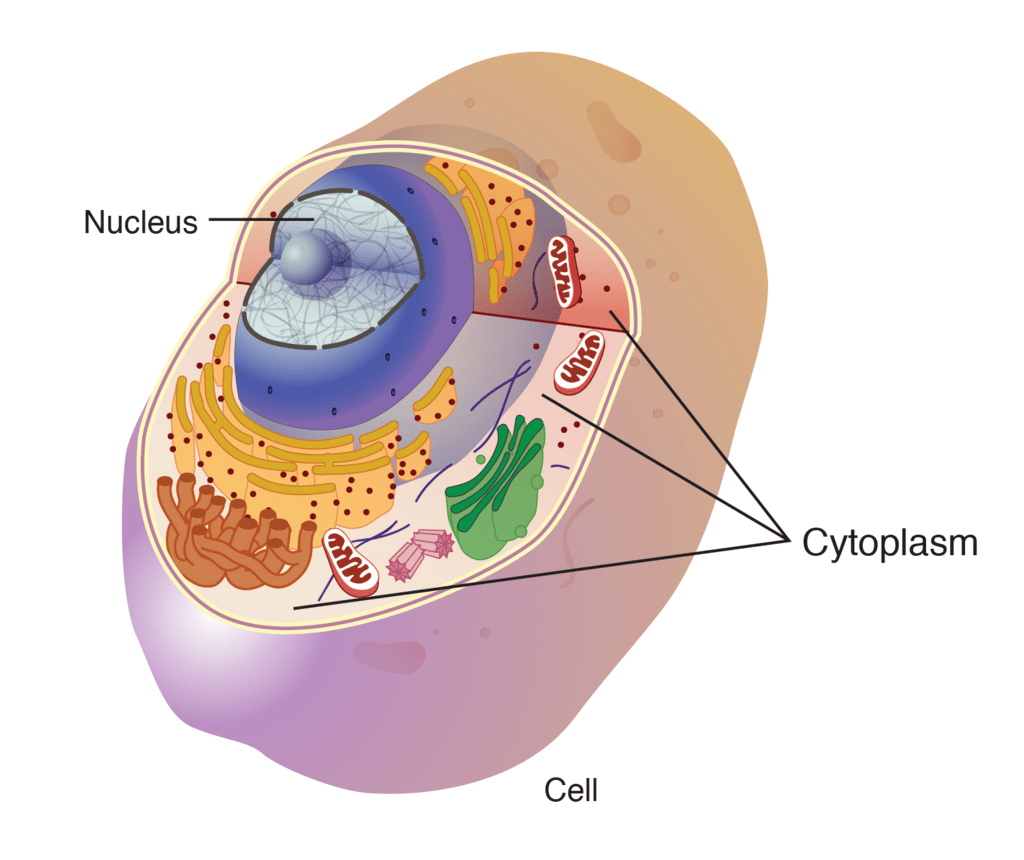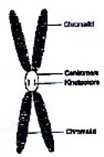Cytoplasm, Cell Organelles and Cell Division | Science Class 9 PDF Download
Cytoplasm

It is a jelly-like, viscous, colourless semi-fluid substance that occurs between the plasma membrane and the nuclear membrane.
The aqueous ground substance of cytoplasm is called cytosol that contains a variety of cell organelles and other insoluble waste products and storage products, like starch, glycogen, lipid, etc.
Functions: → Protoplasm acts as a store of vital chemicals like amino acids, proteins, sugars, vitamins, etc. → It is the site of certain metabolic reactions, like glycolysis, synthesis of fatty acids, nucleotides, etc.
Cell organelles:
Inside the cell there are different parts performing different activities to keep the cell alive anf functionable. These part are called Cell organelles. They are explained below:
1. Golgi Apparatus:
Golgi apparatus consists of a set of membrane bound, fluid filled vesicles, vacuoles and flattened cisternae (closed sacks).
Cisternae are usually arranged parallel to each other.
Functions:
→ Its main function is to store, modify, package and dispatch the substances.
→ It is also involved in the synthesis of cell wall, plasma membrane and lysosomes.
2. Endoplasmic Reticulum:
It is a membranous network of tube like structures extending from nuclear membrane to plasma membrane.
It is absent in prokaryotic cells and matured RBCs of mammals.
There are two types of endoplasmic reticulum: (i) Rough Endoplasmic Reticulum (RER): Here ribosomes are present on the surface for the synthesis of proteins. (ii) Smooth Endoplasmic Reticulum (SER): Here ribosomes are absent and is meant for secreting lipids.
Functions:
→ It gives internal support to cell.
→ It helps in transport of various substances from nuclear membrane to plasma membrane or vice versa.
→ RER helps in synthesis and transportation of proteins.
→ SER helps in synthesis and transportation of lipids.
3. Ribosomes:
These are extremely small, dense and spherical bodies which occur freely in the matrix (cytosol) or remain attached to the endoplasmic reticulum.
These are made up of ribonucleic acid (RNA) and proteins.
Function:
They play a major role in the synthesis of proteins.
4. Mitochondria:
They are small rod-shaped organelles.
It is a double membrane structure with outer membrane being smooth and porous whereas inner membrane being thrown into a number of folds called cristae.
They contain their own DNA and ribosomes.
They are absent in bacteria and red blood cells of mammals.
Functions:
→ They are the sites of cellular respiration, hence provide energy for the vital activities of living cells.
→ They store energy releases during reactions, in the form of ATP (Energy currency of the cell). Therefore, they are also called ‘power house’ of the cell.
5. Centrosome and Centrioles:
Centrosome is found only in eukaryotic animal cells. It is not bounded by any membrane but consists of centrioles.
Centroles are hollow cylindrical structures arranged at right angle to each other and made up of microtubules.
Function:Centrioles help in cell division and also help in the formation of cilia and flagella.
6. Plastids:
Plastids are present in most of the plant cells and absent in animal cells.
They are usually spherical or discoidal in shaped and double membrane bound organelles.
They also have their own DNA and ribosomes.
Plastids are of three types:
(a) Chloroplasts: These are the green coloured plastids containing chlorophyll. Chloroplasts aid in the manufacture food by the process of photosynthesis. (b) Chromoplasts: These are the colourful plastids (except green colour). (c) Leucoplasts: These are the colourless plastids.
Function:
→ Chloroplasts trap solar ebergy and utilise it to manufacture food for the plant.
→ Chromoplasts impart various colours to flowers to attract insects for pollination.
→ Lecuoplasts help in the storage of food in the form of starch, proteins and fats.
7. Lysosomes:
Lysosomes are small, spherical, sac like structures which contain several digestive enzymes enclosed in a membrane.
They are found in eukaryotic cells mostly in animals.
Functions:
→ Lysosomes help in digestion of foreign substances and worn-out cell organelles.
→ They provide protection against bacteria and virus.
→ They help to keep the cell clean.
→ During the disturbance in cellular metabolism, for example when the cell gets damaged, lysosomes may burst and the enzymes digest their own cell. Therefore, lysosomes are also known as suicide bags of a cell
8. Vacuoles:
Vacuoles are liquid/solid filled and membrane bound organelles.
In plant cells, vacuoles are large and permanent. In animal cells, vacuoles are small In size and temporary.
In mature plant cell, It occupies 90% space of cell volume.
Due to its size, other organelles, including nucleus shift towards plasma membrane.
Function:
→ They help to maintain the osmotic pressure in a cell.
→ They provide turgidity and rigidity to the plant cell.
9. Peroxiomes:
They are small and spherical organelles containing powerful oxidative enzymes.
They are bounded by a single membrane.
They are found in kidney and liver cells.
Function:
→ They are specialized to carry out some oxidative reactions, such as detoxification or removal of toxic substances form cell.
Chromosome


At the time of cell division the chromatin threads separate apart from one another and become smaller and thicker, are called chromosome.
A chromosome is a deeply staining, rodlike structure with a part that is usually constricted. This is the point of primary constriction called the centromere.
The chromosomes are defined by their length and the position of centromeres
- If the position of the centromere is such that the two arms of the chromosomes are equal then it is called metacentric.
- If one of the arms of the chromosome is smaller than the other, it is called submetacentric.
- If one arm of the chromosome is considerably smaller than the other, this straight chromosome is called acrocentric.
- When the centromere occupies one end of the chromosome, it is called telocentric.
The tips of chromosomes are called telomeres.
Prokaryotic Chromosomes
Prokaryotic Chromosomes are composed of DNA. But they are circular as the two ends of the DNA are joined. There is only one chromosome in a prokaryotic cell. This chromosome is not complexed with proteins (histones and acidic proteins), which is a characteristic of eukaryotic chromosomes.
Eukaryotic Chromosome
Eukaryotic chromosome results from the condensation of the chromatin, which happens only during the early part of cell division. In this condensed state its genes are not active.
Number of Chromosomes
The number of chromosomes within the nucleus is constant in all individuals of a given species. For example, there are 46 chromosomes in a human being ; 40 in a mouse ; 8 in a fruitfly (Drosophila melanogaster) ; 20 in maize ; 24 in tomato and 48 in potato. As it represents two sets of chromosomes, one set received from each parent, this number is called the diploid number of chromosomes. The nucleus of a gamete (egg or sperm) contains half this number of chromosomes, or the haploid number. Thus a human gamete contains 23 chromosomes. A haploid set of chromosomes is called genome.
Do you know?
- Chromatin threads are made up of
(i) DNA (ii) Protein [Histone protein] - Gene: The segment of DNA and act as unit of heredity
ATP(Adenosine triphosphate)
It is also known as energy currency. It provides energy to perform bio-synthesis & mechanical work.
- Homologous Chromosomes: All chromosomes are found in pair and the chromosomes of a pair are called homologous chromosomes.
- Non-homologous Chromosomes: Chromosomes of different pair.
- The nucleus of prokaryotes is also known nucleoid.
- Nucleus is also called director of cell as it controls most of the cellular activities.
- Nucleus is absent in sieve tubes of vascular plants & mature RBC's of mammals. Mammalian RBC also lacks Golgibodies, mitochondria, ER, lysosomes.
|
88 videos|369 docs|67 tests
|
FAQs on Cytoplasm, Cell Organelles and Cell Division - Science Class 9
| 1. What is cytoplasm and what are its functions? |  |
| 2. What is the role of chromosomes in cell division? |  |
| 3. What are cell organelles and why are they important? |  |
| 4. How does the cytoplasm contribute to cell metabolism? |  |
| 5. How does cell division contribute to the growth and development of organisms? |  |

|
Explore Courses for Class 9 exam
|

|

















